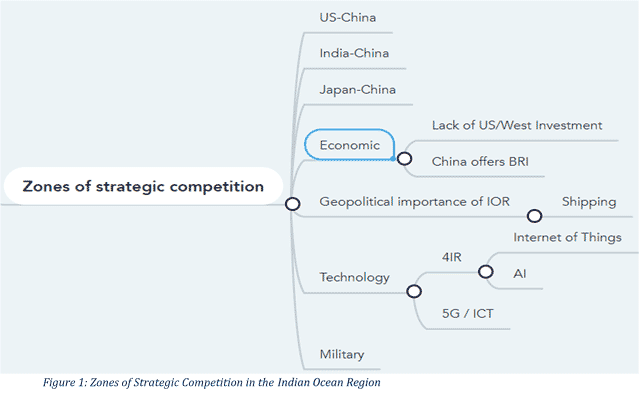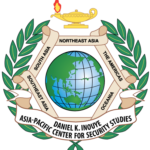By Saira Yamin, Daniel Cedillo, Nicholas Sikes, Srini Sitaraman, Keith Wilkins*
Introduction
This article draws on conversations facilitated at the virtual Indian Ocean Region Workshop convened by the Daniel K. Inouye Asia-Pacific Center for Security Studies (DKI APCSS) in Honolulu, Hawaii, in partnership with its sister security studies center, the Near East South Asia Center for Strategic Studies (NESA) in Washington D.C. The workshop occurred over three consecutive days from Dec. 7 – 9, 2020.[1] Over 90 participants from 14 nations participated in the deliberations focusing on two key objectives: (i) Define the diverse perspectives on strategic competition and its effects on the Indian Ocean Region, and (ii) Explore opportunities for cooperation between partners, allies, and the United States (U.S.). Aligned with the DKI APCSS mission to “educate, connect and empower,” the workshop created soft academic space for an inclusive, transparent, and mutually respectful dialogue in an otherwise restrictive pandemic environment. Regional security practitioners and influencers, including DKI APCSS alumni, led the dialogue by providing a rich diversity of perspectives and opinions on strategic competition, emerging flashpoints, and its effects. Opportunities for cooperation were viewed from both a regional and an extra-regional perspective, which is how the U.S. was classified by most international participants. Connecting civilians, scholars, researchers, and military officials from many countries to contribute regional perspectives and listen to security challenges helped build a shared understanding. This provided the foundation for security practitioners to traverse and transcend national and sub-regional boundaries in the collective pursuit of regional security objectives. In keeping with the DKI APCSS non-attribution policy, names of individuals and countries have been withheld.
Context: Intensifying Strategic Competition between the United States and China
Strategic Competition between the U.S. and China has been looming in the distance and has finally come to the forefront of global conversation, strategy, and policy. The competition is intensifying in the Indian Ocean Region. This vast and open region bookends Bahrain to Djibouti to Diego Garcia to Singapore. The sea lanes of the Indian Ocean play a significant role in the transit of commercial and energy traffic. The lanes interlink the strategically important Suez Canal with another strategically critical channel–the Malacca Straits. China has realized the vital importance of the sea – and its ambitions can often be summed up by Alfred Mahan’s sea power theory “whoever controls the Indian Ocean will dominate Asia.” Seemingly China is vying to expand its influence in the region without having to fight a war with its competitors. For China, the Global War on Terror waged by the U.S. was invaluable as it allowed for at least a decade and a half of uninterrupted political and economic growth. It provided China the time it needed to build itself into the power it is today. Undoubtedly, China seeks global leadership and is steadily working to create a new global order defined by its own set of rules, norms, and values. Innovation in technology and the “4th Industrial Revolution” have only strengthened China’s position and further fueled the fires of strategic competition with the U.S. The fight between these Great Powers is expected to move beyond the kinetic in pursuit of warfare by other means. The new “fight” will be waged on the battlefields of maritime, cyberspace, information, space, and economic competition.
With this backdrop, the article highlights the diversity of perspectives on strategic competition and opportunities for cooperation in the Indian Ocean Region drawing on discussions at the three-day virtual workshop organized by DKI APCSS.
Workshop Highlights
Objective 1: Diverse Perspectives on Strategic competition and its effects in the Indian Ocean Region
A Complex Landscape: Many Players and Many Layers
U.S.-China strategic competition in the Indian Ocean Region may be viewed through multiple lenses: (i) the quest for greater power projection and strategic access, (ii) the drive for stronger maritime and littoral footprints, and (iii) economic development, encompassing both trade and investments. It is worth noting, however, that many Indo-Pacific nations believe the U.S.-China strategic competition is neither the defining feature nor the most accurate prism for understanding the complexity of the regional security environment. Many players and layers need to be taken into account to understand the big picture.
Considering the whole expanse of the region, the waters around the Western Indian Ocean are getting very crowded. There is a coastal infrastructure boom in the East African coastline provoking a Great Power Competition for basing and resource control in the region. Extra-regional and regional powers including Russia, China, United States, France, and India are jostling for space in the ocean. Additionally, the crisis in the Middle-East is drawing multiple state and non-state actors into the region. The maritime security of littoral states is of growing importance as they seek to secure lucrative energy resources and secure its passage. Other intersecting regional power competitions and active territorial and water conflicts involving states such as India, Pakistan, Sri Lanka, Maldives, Bangladesh, and Myanmar are also in play. Collectively all of this has led to an arms race in the Indian Ocean Region. The states have started expanding their naval capacity by accelerating ship-building and purchasing battleships, helicopters, radar systems, and submarines. For instance, the People’s Liberation Army-Navy is developing a naval expeditionary force and India is considering the purchase of a third aircraft carrier. China was once India’s greatest trading partner, but due to competing agendas along their borders, the China-India partnership is at the crossroads. Middle powers play an important role, including balancing between India and China, the U.S. and China, and other regional competitors.
The factor that is sometimes lost during these challenges is the smaller state perspectives, critical to what is best for the region. Large regional and extra-regional countries need to recognize the significant geostrategic importance of smaller, littoral nations. For most countries in the region, particularly the smaller developing states, economic interests precede strategic needs (see Figure 1 representing workshop discussions). For many of these small and middle powers, non-traditional threats to security, including climate change, natural disasters, environmental degradation, and transnational threats such as terrorism and violent extremism, piracy, Illegal, Unregulated and Unreported Fishing (IUUF), human and drug trafficking are high on national priorities.
Choices and Opportunities for Growth for Small and Middle Powers
For some states in the Indian Ocean Region, the evolving Great Power Competition provides new opportunities for growth and expansion. It gives choices not previously offered to some of the smaller and middle powers. Often, the U.S. is perceived as an “extra” regional power, and some countries are hesitant to fully engage with it at the cost of alienating China. Importantly, they don’t want to be entangled in Great Power politics and would prefer to maintain good relations with both. They do not favor having to choose one over the other. It is in their interest to continue developing with assistance from multiple regional and extra-regional powers. The smaller regional countries must also balance the relationships they have with China, the U.S., India, and others. They desire friendly relations with many of these countries simultaneously but are sometimes constrained by geographic proximity, capacity, historical and political factors, or economic dependence on China. Some smaller littoral states find they are thriving in an environment shaped by Great Power Competition as it gives them greater leverage to negotiate their choices.
The most overwhelming viewpoint offered by participants was that of choice. The countries in the Indian Ocean Region want options. China, the main contributor in the area, has focused its attention on expanding its supply and logistics. This has brought infrastructure and capital growth into the region. These growth opportunities come with a China price tag that some countries may or may not be willing to pay. Increased U.S. presence in the region and the added option to work with the U.S. and allies allow countries to bargain from a position of strength. It will enable countries in the region to choose who they work with and in what areas. When it comes to economic prosperity, some countries will choose the U.S., and some will choose China, but most will choose both. These new economic growth opportunities will naturally foster new avenues to build and re-build partnerships in the Indian Ocean Region
Economic Development and Cooperation: China’s Principal Strategic Tool
China’s long-run objective is to protect and control resources. Economic development is the key, and economic cooperation is the vehicle for China’s rapid progress and the principal strategic tool. It uses economic incentives to attract countries to gain effective and increased control of fisheries, gas, energy, and sea lanes of communications to strengthen its position in the region. Its soft power, extended through economic and infrastructure development and more recently through COVID diplomacy, has been instrumental in expanding its influence. Several workshop participants voiced that an absence of investment from the West has created a vacuum that China has sought to fill through the ambitious Belt and Road Initiative (BRI). The BRI supports China’s strategy in the Indian Ocean Region through debt funding of some of the littoral states’ infrastructure needs. It has been one of the primary leverage points for China’s strategy while also enabling India’s encirclement. Large scale signature capital projects and Mandarin language courses, for example, are ways how China has stepped in to strengthen its ties with Indian Ocean littoral states. U.S. capital and economic investments are deemed necessary to improve its footprint and strengthen partnerships in the region.
Workshop Highlights
Objective 2: Opportunities for cooperation in an environment of strategic competition
Small, Middle and Large Powers: Shifting Alliances and Opportunities for Cooperation
As elucidated above, the global focus on the Indo-Pacific has led to new opportunities for cooperation. During this period of emerging transformation, old partnerships will fade, and new ones will emerge. Small, middle, and great powers, both regional and extra-regional, should seize the opportunity to build partnerships based on shared interests, deepen their cooperation, and strengthen a rules-based order protecting and benefiting themselves and the global community. It is important to note that these opportunities to cooperate will allow small and middle powers to take a more relevant and active role in the future of the Indian Ocean Region.
While some states maintain a non-alignment policy, they should all continue to strengthen relationships in the region. Multilateral engagements provide an opportunity for collaboration without the appearance of choosing sides. Workshop participants overwhelmingly advocated for multilateral approaches in lieu of the series of bilateral agreements currently in place. A multilateral system provides for strategic ambiguity and allows nations to maintain a non-aligned posture. Multilateral organizations offer several opportunities to collaborate, including humanitarian assistance and disaster relief, transnational crime, climate change, economic development, technology transfer, and research and development. One or more of these offer opportunities to build the foundations of multilateral cooperation in an environment of strategic competition between Great Powers.
To demonstrate that competition can potentially generate opportunities for more inclusive and optimal solutions, it is important to create forums for dialogue with China. Consider the immensely productive possibility of a globally coordinated response to COVID-19 and vaccine diplomacy. Such cooperation would be a win-win for all. It would help strengthen ties in the region and act as a catalyst for cooperation in the new era of Great Power Competition. Modeling transparency in lessons learned and coordinating a global vaccine distribution plan could help the world come together to combat the pandemic, turning a monumental crisis into a historic opportunity to collaborate. Removing politics from scientific cooperation is of the essence. Actions like this will reduce mistrust and eventually help to build greater trust and confidence. Multilateral platforms and regional organizations, both existing and new, could help with confidence building exercises in the region.
Strategic Competition, Cooperation, and Accommodation
While participants from the region vehemently advocated for opportunities to deepen cooperation and identify common interests for multilateral engagement, they suggested veering the Great Power dynamics from strategic competition to accommodation. This view offers the opportunity for the U.S. and China to listen to the region and generate collaborative solutions. Such cooperation, however, is contingent on building trust, or at the very least reducing mistrust. It is also conditional on open dialogue between strategic competitors, the Great Powers. Importantly it is an opportunity for the U.S. to reframe its leadership by supporting ongoing regional efforts and filling in the gaps where possible. Given that the U.S. is an extra-regional power, a stance that supports regional initiatives and is willing to accommodate China offers an opportunity to fit in quite well. The model is not an entirely new one. A number of countries are actively engage in “multi-directional balancing” or “cross-alignment” to accommodate various players competing for influence in the region. A number of areas were identified as offering the space for strategic accommodation between the U.S. and China. Those generated in one of the small group discussions at the workshop are given in Figure 2 below. They include economic cooperation, technological cooperation, climate change, and humanitarian assistance in disaster response along with shared maritime domain awareness.
Workshop participants also discussed infrastructure development assistance by the U.S. and its allies for increased Indo-Pacific connectivity to supplement and compliment BRI projects. Additionally, participants considered drawing together all efforts of the European Union and the QUAD nations (Japan, India, the U.S., and Australia) to support the Association for South East Asian Nations (ASEAN) infrastructure strategies as the healthy, transparent alternative to the BRI. Attendees viewed foreign direct investment in the region as having immense potential to build the confidence of small, middle and rising powers in the region.
Technology has long been both the driver and vector for competition in the Indian Ocean Region. Several participants noted that with the coming of the 4th Industrial Revolution, 5G, artificial intelligence, and many more technological updates, the need for clean technology will become essential to national sovereignty. It was identified as a rapidly emerging area for cooperation. They noted that currently, Huawei Technologies is the one of the few providers, and generally the most cost-effective one, of information and communications technology (ICT) to the Indian Ocean Region. While many nations are wary of entering deals with what they termed “dirty technology,” given a noted absence or vast cost difference in alternatives, they fear they will get technologically even further behind if they do not choose what is available to them in the near future.
Another popular area cited for possible cooperation was that of Maritime Domain Awareness (MDA) information sharing as part of Information Fusion Centers. Representatives believed MDA knowledge by regional nations would assist in maintaining the rule of law, international norms, and support a Free and Open Indo-Pacific. Indian Ocean states are keen on economic development opportunities but they must be within the rule of law, international norms, and good governance. Impacts to the global economy from challenges and threats such as climate change and Illegal Unreported and Unregulated Fishing (IUUF) directly impact the Indian Ocean Region and beyond. Successful strategic coordination to combat IUUF will have a direct impact on climate change. These are important linkages in considering opportunities to transform an environment of strategic competition to that of strategic cooperation and accommodation between Great Powers.
Conclusion
Intensifying strategic competition in the Indian Ocean Region offers new strategic opportunities. It is a moment of global transition. U.S. policy requires nuance and balance in response to China’s rise as a competitor. Perspectives from the region elicited at the virtual workshop highlighted the complexity of the security landscape. Great power interests are diverse and conflicting yet there is also opportunity to build common ground. The region features a web of multi-faceted relationships between small, medium and Great Powers confronting a broad spectrum of traditional and non-traditional security threats. Looking beyond the prism of Great Power Competition, these sub-regional dynamics need to be better understood to maximize the gains for stakeholders. Underlying national interests, particularly those of smaller and middle powers, are frequently overlooked. Economic development is often high on the list of national priorities in the region and when it comes to pursuing options for growth and prosperity, littoral states want what is best for them. While the cost of deepening economic relationship with China may come with high political and security costs, and long-term economic consequences, littoral states seemingly overlook them in favor of short-term gains. The U.S. could demonstrate greater leadership by truly listening to what the region wants and continue to push for and be receptive to open dialogue with China. Opening up channels of communication and sustained engagement is imperative
As old alliances shift and new partnerships evolve, Indian Ocean countries would like to balance their relations with both China and the U.S. Choosing one over the other at the cost of alienating either is neither desirable, practicable, nor necessary. Going forward, the creation of multilateral frameworks could carve the space for cooperation. Great Powers, on their part, should consider shifting the dynamics of competition to accommodation. The change in the U.S. administration may generate new possibilities for such cooperation with China. Their relationship with littoral states could be mutually complementary. Such a shift, however, is dependent on reducing mistrust and reframing policy to accommodate regional priorities. Soft issues such as health security, environment and climate change, and economic cooperation are critically important for littoral states and offer the greatest space for win-win outcomes. Some of these strategic points of intervention could help build the foundations for multilateral cooperation between Great Powers. Ultimately, strategic competition benefit everyone when it helps build regional and international stability, security, and resilience.
*All authors are professors at the Daniel K. Inouye Asia-Pacific Center for Security Studies (DKI APCSS) in Honolulu, USA. The views expressed in this article are the author’s alone, and do not necessarily reflect the official position of the DKI APCSS or the United States Government.
The workshop leadership team included DKI APCSS Professors Wade Turvold, Captain, U.S. Navy (ret) and Captain Kimberly B. McCann, U.S. Navy.
Published: March 23, 2021
Category: Perspectives
Volume: 22 - 2021






